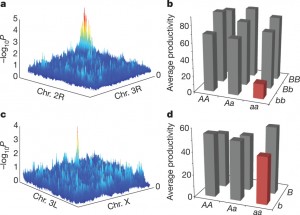The role and importance of epistasis (non-additive interactions between alleles) in shaping genetic variation, and its effects on fitness have been the focus of much debate. Russell et al. recently investigated the genomic footprint of epistatic fitness effects. Starting from two sets of 8 highly inbred Drosophila melanogaster strains, they created 4 panels of 400 recombinant inbred lines. Then, they investigated non independent allelic segregation of pairs of unlinked loci (i.e. on different chromosomes; figure 1 a and c). Indeed, it is expected that unfavourable allelic combinations will be under-represented in a the population. This deviation from Mendelian proportions was refereed as genotype ratio distortion (GDP).

22 pairs of epistatically interacting alleles could be identified. Many of the incompatible alleles are present in more than one founder strain, suggesting that they were segregating in natural populations. They estimated that any pairwise combination of founder strains has, on average, 1.15 pairs of epistatically interacting alleles .
They performed experimental crosses in order to investigate two incompatibilities in more details. They discovered that the negative interaction is caused by the minor alleles at each locus in both cases (Figure 1 b, d). Interestingly, both involved a reduction in male fertility (with respectively 74% and 22% fewer offsprings).
Finally, in order to confirm that these observations are not specific to D. melanogaster , they used a similar approach to screen for GRD in two additional species: Arabidopsis and maize. 7 cases of GRD were identified in Arabidopsis, 5 in maize.
This work shows that epistasis with fitness effects has a detectable genomic footrint, and supports the idea that incompatibilities are widespread within populations. The authors finally discussed the possibility that reproductive isolation and speciation could be achieved through divergence in frequencies of numerous incompatible variants, and would not necessarily require the emergence of incompatible mutations independently derived and fixed in allopatric lineages.
Reference:
Corbett-Detig, R., Zhou, J., Clark, A., Hartl, D., & Ayroles, J. (2013). Genetic incompatibilities are widespread within species Nature, 504 (7478), 135-137
